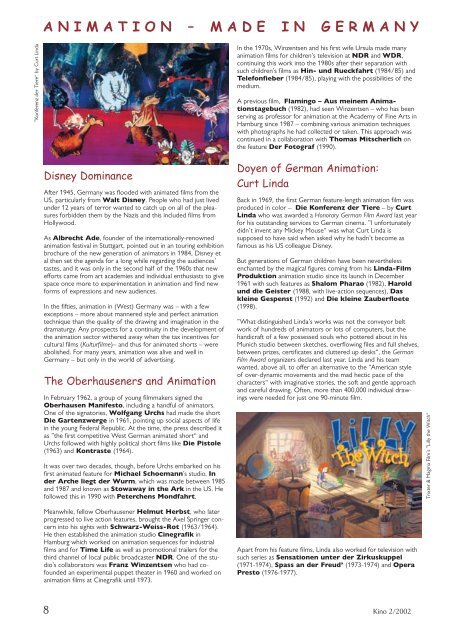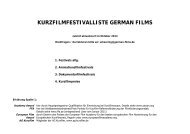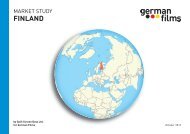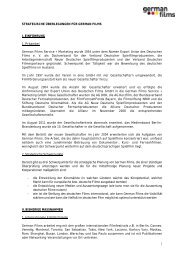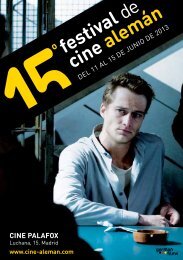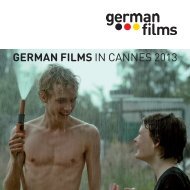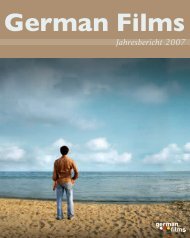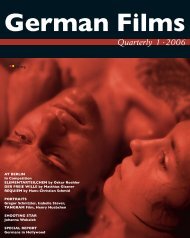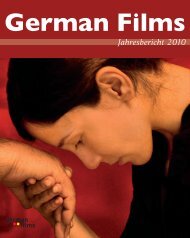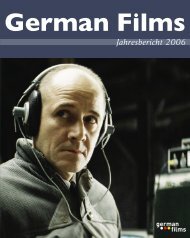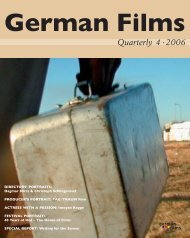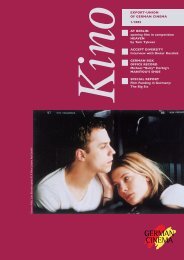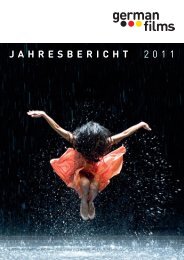Titel Kino 2/2002 - german films
Titel Kino 2/2002 - german films
Titel Kino 2/2002 - german films
Create successful ePaper yourself
Turn your PDF publications into a flip-book with our unique Google optimized e-Paper software.
”Konferenz der Tiere“ by Curt Linda<br />
ANIMATION – MADE IN GERMANY<br />
Disney Dominance<br />
After 1945, Germany was flooded with animated <strong>films</strong> from the<br />
US, particularly from Walt Disney. People who had just lived<br />
under 12 years of terror wanted to catch up on all of the pleasures<br />
forbidden them by the Nazis and this included <strong>films</strong> from<br />
Hollywood.<br />
As Albrecht Ade, founder of the internationally-renowned<br />
animation festival in Stuttgart, pointed out in an touring exhibition<br />
brochure of the new generation of animators in 1984, Disney et<br />
al then set the agenda for a long while regarding the audiences’<br />
tastes, and it was only in the second half of the 1960s that new<br />
efforts came from art academies and individual enthusiasts to give<br />
space once more to experimentation in animation and find new<br />
forms of expressions and new audiences.<br />
In the fifties, animation in (West) Germany was – with a few<br />
exceptions – more about mannered style and perfect animation<br />
technique than the quality of the drawing and imagination in the<br />
dramaturgy. Any prospects for a continuity in the development of<br />
the animation sector withered away when the tax incentives for<br />
cultural <strong>films</strong> (Kulturfilme)– and thus for animated shorts – were<br />
abolished. For many years, animation was alive and well in<br />
Germany – but only in the world of advertising.<br />
The Oberhauseners and Animation<br />
In February 1962, a group of young filmmakers signed the<br />
Oberhausen Manifesto, including a handful of animators.<br />
One of the signatories, Wolfgang Urchs had made the short<br />
Die Gartenzwerge in 1961, pointing up social aspects of life<br />
in the young Federal Republic. At the time, the press described it<br />
as ”the first competitive West German animated short“ and<br />
Urchs followed with highly political short <strong>films</strong> like Die Pistole<br />
(1963) and Kontraste (1964).<br />
It was over two decades, though, before Urchs embarked on his<br />
first animated feature for Michael Schoemann’s studio, In<br />
der Arche liegt der Wurm, which was made between 1985<br />
and 1987 and known as Stowaway in the Ark in the US. He<br />
followed this in 1990 with Peterchens Mondfahrt.<br />
Meanwhile, fellow Oberhausener Helmut Herbst, who later<br />
progressed to live action features, brought the Axel Springer concern<br />
into his sights with Schwarz-Weiss-Rot (1963/1964).<br />
He then established the animation studio Cinegrafik in<br />
Hamburg which worked on animation sequences for industrial<br />
<strong>films</strong> and for Time Life as well as promotional trailers for the<br />
third channel of local public broadcaster NDR. One of the studio’s<br />
collaborators was Franz Winzentsen who had cofounded<br />
an experimental puppet theater in 1960 and worked on<br />
animation <strong>films</strong> at Cinegrafik until 1973.<br />
8<br />
In the 1970s, Winzentsen and his first wife Ursula made many<br />
animation <strong>films</strong> for children’s television at NDR and WDR,<br />
continuing this work into the 1980s after their separation with<br />
such children’s <strong>films</strong> as Hin- und Rueckfahrt (1984/85) and<br />
Telefonfieber (1984/85), playing with the possibilities of the<br />
medium.<br />
A previous film, Flamingo – Aus meinem Animationstagebuch<br />
(1982), had seen Winzentsen – who has been<br />
serving as professor for animation at the Academy of Fine Arts in<br />
Hamburg since 1987 – combining various animation techniques<br />
with photographs he had collected or taken. This approach was<br />
continued in a collaboration with Thomas Mitscherlich on<br />
the feature Der Fotograf (1990).<br />
Doyen of German Animation:<br />
Curt Linda<br />
Back in 1969, the first German feature-length animation film was<br />
produced in color – Die Konferenz der Tiere – by Curt<br />
Linda who was awarded a Honorary German Film Award last year<br />
for his outstanding services to German cinema. ”I unfortunately<br />
didn’t invent any Mickey Mouse“ was what Curt Linda is<br />
supposed to have said when asked why he hadn’t become as<br />
famous as his US colleague Disney.<br />
But generations of German children have been nevertheless<br />
enchanted by the magical figures coming from his Linda-Film<br />
Produktion animation studio since its launch in December<br />
1961 with such features as Shalom Pharao (1982), Harold<br />
und die Geister (1988, with live-action sequences), Das<br />
kleine Gespenst (1992) and Die kleine Zauberfloete<br />
(1998).<br />
”What distinguished Linda’s works was not the conveyor belt<br />
work of hundreds of animators or lots of computers, but the<br />
handicraft of a few possessed souls who pottered about in his<br />
Munich studio between sketches, overflowing files and full shelves,<br />
between prizes, certificates and cluttered up desks“, the German<br />
Film Award organizers declared last year. Linda and his team<br />
wanted, above all, to offer an alternative to the “American style<br />
of over-dynamic movements and the mad hectic pace of the<br />
characters“ with imaginative stories, the soft and gentle approach<br />
and careful drawing. Often, more than 400,000 individual drawings<br />
were needed for just one 90-minute film.<br />
Apart from his feature <strong>films</strong>, Linda also worked for television with<br />
such series as Sensationen unter der Zirkuskuppel<br />
(1971-1974), Spass an der Freud’ (1973-1974) and Opera<br />
Presto (1976-1977).<br />
<strong>Kino</strong> 2/<strong>2002</strong><br />
Trixter & Magma Film’s ”Lilly the Witch“


